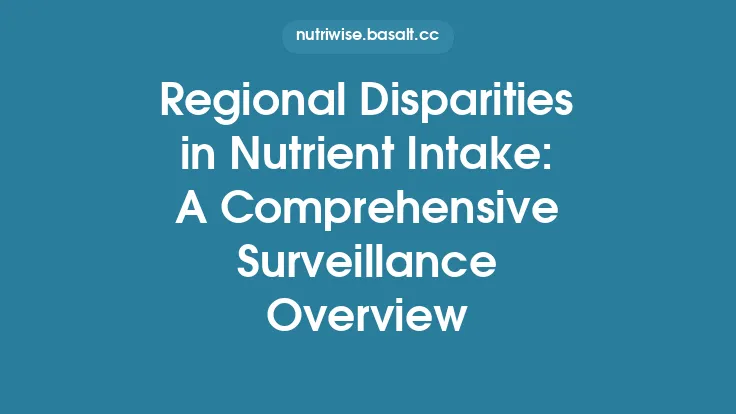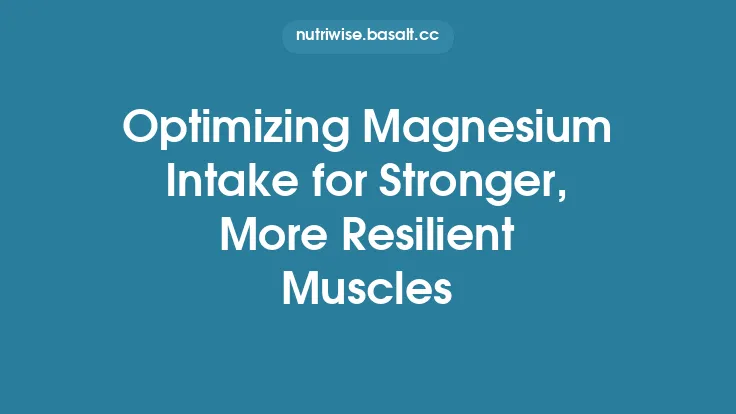Nutrient intake assessment has long relied on self‑reported methods that are prone to recall bias, misreporting, and limited granularity. Biomarkers—objective, quantifiable measures that reflect the absorption, metabolism, or physiological effect of a nutrient—offer a powerful alternative or complement to traditional dietary surveys. Over the past decade, the field has witnessed a series of methodological breakthroughs that have sharpened the precision, reproducibility, and interpretability of biomarker‑based intake estimates. This article surveys the most consequential advances in biomarker validation, outlining the scientific principles, analytical innovations, and statistical frameworks that together constitute the modern toolkit for nutrition researchers.
Foundations of Biomarker Validation
Defining a Valid Biomarker
A biomarker for nutrient intake must satisfy several core criteria:
- Specificity – The marker should respond primarily to the nutrient of interest, with minimal cross‑reactivity to other dietary components or endogenous pathways.
- Sensitivity – Detectable changes in the biomarker should correspond to physiologically relevant variations in intake.
- Temporal Resolution – The kinetic profile (e.g., half‑life, post‑prandial peak) must align with the research question, whether short‑term absorption or long‑term status is being examined.
- Biological Plausibility – The marker should be situated within a well‑characterized metabolic pathway, allowing mechanistic interpretation.
- Analytical Robustness – The assay must demonstrate low intra‑ and inter‑assay variability, adequate limits of detection, and resistance to matrix effects.
These criteria, originally articulated in the 2001 WHO/FAO guidelines, remain the benchmark against which new candidates are judged. Recent work has refined the operational definitions of specificity and sensitivity by incorporating dose‑response modeling and controlled feeding trials.
The Validation Pipeline
Modern validation follows a staged pipeline:
| Stage | Objective | Typical Design |
|---|---|---|
| Discovery | Identify candidate metabolites or proteins linked to intake | Controlled feeding, untargeted metabolomics, proteomics |
| Analytical Validation | Confirm assay performance (precision, accuracy) | Replicate measurements, spike‑recovery, inter‑lab comparisons |
| Biological Validation | Demonstrate dose‑response and temporal dynamics | Randomized dose‑escalation studies, time‑course sampling |
| Epidemiological Validation | Assess predictive value in free‑living populations | Cross‑sectional and prospective cohort analyses |
| Implementation | Translate into routine use (clinical, public health) | Standard operating procedures, reference ranges |
Each stage now benefits from methodological advances that reduce uncertainty and accelerate progression to the next step.
Technological Advances in Analytical Platforms
High‑Resolution Mass Spectrometry (HRMS)
The advent of Orbitrap and time‑of‑flight (TOF) instruments with sub‑ppm mass accuracy has transformed targeted and untargeted biomarker quantification. HRMS enables:
- Isotopic Pattern Recognition – Distinguishing endogenous metabolites from dietary contaminants.
- Multiplexed Quantification – Simultaneous measurement of dozens of nutrient‑related metabolites in a single run, preserving sample volume.
- Improved Limit of Detection – Sub‑nanomolar sensitivity for trace vitamins and trace elements.
Coupled with stable isotope‑labeled internal standards, HRMS now delivers intra‑assay coefficients of variation (CV) below 5 % for many micronutrient biomarkers.
Nuclear Magnetic Resonance (NMR) Spectroscopy
While traditionally viewed as less sensitive than MS, modern 600 MHz NMR spectrometers equipped with cryoprobes have achieved detection limits compatible with most macro‑ and micronutrient metabolites. NMR offers distinct advantages:
- Absolute Quantification without the need for external calibration curves.
- Non‑Destructive Sampling, allowing subsequent analyses (e.g., DNA extraction) from the same specimen.
- Robustness to Matrix Effects, making it ideal for high‑throughput screening of plasma or urine.
Recent methodological papers demonstrate that NMR‑derived biomarkers for fatty acid intake (e.g., plasma linoleic acid) correlate strongly (r > 0.85) with gold‑standard gas chromatography measurements.
Immunoassay Evolution
Enzyme‑linked immunosorbent assays (ELISAs) remain the workhorse for vitamins such as B12 and D. Innovations include:
- Multiplexed Bead‑Based Platforms (e.g., Luminex) that quantify up to 30 nutrients simultaneously.
- Recombinant Antibody Engineering to improve affinity and reduce cross‑reactivity.
- Automation and Microfluidics that cut assay time from hours to minutes while maintaining CV < 3 %.
These refinements have broadened the accessibility of biomarker testing to clinical laboratories lacking high‑end MS infrastructure.
Standardization and Reference Materials
Certified Reference Materials (CRMs)
The establishment of CRMs for nutrient biomarkers (e.g., NIST SRM 1950 Human Plasma) has been pivotal. By providing matrix‑matched standards with known concentrations, CRMs enable:
- Inter‑Laboratory Comparability – Harmonized results across research consortia.
- Method Calibration – Accurate quantification across different analytical platforms.
- Quality Assurance – Routine verification of assay performance.
Recent collaborative studies have shown that when laboratories calibrate against the same CRM, inter‑lab variability for serum vitamin D drops from 15 % to < 5 %.
Harmonized Protocols
International bodies such as the International Society for the Advancement of Nutritional Sciences (ISANS) have published consensus SOPs for sample collection, storage, and processing. Key recommendations include:
- Immediate Plasma Separation within 30 minutes of venipuncture to prevent enzymatic degradation.
- Aliquoting and Cryopreservation at –80 °C to preserve labile metabolites.
- Use of Antioxidant Additives (e.g., ascorbic acid for vitamin C) when appropriate.
Adherence to these protocols mitigates pre‑analytical variability, a major source of error in biomarker studies.
Statistical Frameworks for Validation
Dose‑Response Modeling
Non‑linear mixed‑effects models (NLME) have become the standard for characterizing the relationship between intake and biomarker concentration. By incorporating random effects for individual variability and fixed effects for dose, researchers can estimate:
- Effective Dose (ED50) – The intake level that yields 50 % of the maximal biomarker response.
- Saturation Points – Intake levels beyond which the biomarker plateaus, indicating homeostatic regulation.
These models are particularly useful for nutrients with tight physiological control, such as iron.
Calibration Equations
To translate biomarker concentrations into estimated intake, calibration equations are derived from controlled feeding data. The most robust approach employs regression calibration combined with measurement error models to correct for within‑person variability. Validation studies now routinely report:
- R² values for the calibration (often > 0.70 for well‑validated markers).
- Bias estimates (e.g., mean absolute error) when applying the equation to free‑living cohorts.
Receiver Operating Characteristic (ROC) Analysis
When the goal is to classify individuals as deficient, sufficient, or excessive, ROC curves quantify the discriminative ability of a biomarker. Recent work on plasma selenium has achieved an area under the curve (AUC) of 0.92 for distinguishing sub‑optimal from adequate intake, surpassing traditional dietary questionnaires.
Multi‑Biomarker Composite Scores
For complex nutrients (e.g., polyunsaturated fatty acids), researchers now construct composite indices using principal component analysis (PCA) or partial least squares regression (PLSR). These scores capture the integrated signal from several related metabolites, improving predictive accuracy and reducing the impact of any single assay’s variability.
Integration of Multi‑Omics Data (Beyond Metabolomics)
While metabolomics remains a cornerstone of biomarker discovery, the integration of proteomics, transcriptomics, and epigenomics offers a richer, systems‑level view of nutrient status.
- Proteomic Signatures – Quantification of transport proteins (e.g., transferrin for iron) can complement concentration measurements of the nutrient itself.
- Transcriptomic Markers – Gene expression profiles responsive to nutrient availability (e.g., SLC23A1 for vitamin C transport) provide mechanistic insight and may serve as early indicators of deficiency.
- Epigenetic Modifications – DNA methylation patterns linked to long‑term nutrient exposure (e.g., folate‑related CpG sites) are emerging as potential retrospective biomarkers.
Statistical integration methods such as multi‑block data analysis and network‑based approaches enable the simultaneous evaluation of these layers, yielding composite biomarkers with enhanced specificity.
Illustrative Case Studies of Validated Biomarkers
Vitamin D (25‑Hydroxyvitamin D)
- Analytical Platform – LC‑MS/MS with isotope‑labeled internal standards.
- Validation Highlights – Dose‑response established across 0–4000 IU/day; inter‑lab CV < 4 %; calibration equation with R² = 0.78.
- Clinical Utility – Widely adopted for assessing skeletal health and emerging links to immune function.
Iodine (Urinary Iodine Concentration)
- Analytical Platform – Inductively coupled plasma mass spectrometry (ICP‑MS).
- Validation Highlights – Spot urine samples calibrated against 24‑hour collections; intra‑individual CV ≈ 12 % (acceptable given biological variability); WHO cut‑offs validated in multiple populations.
- Public Health Impact – Basis for national salt iodization monitoring programs.
Omega‑3 Fatty Acids (Plasma Phospholipid EPA/DHA)
- Analytical Platform – Gas chromatography with flame ionization detection (GC‑FID) and confirmatory HRMS.
- Validation Highlights – Non‑linear mixed‑effects model captures saturation at ~2 g/day; composite score of EPA + DHA improves correlation with dietary intake (R² = 0.71).
- Research Relevance – Used in cardiovascular outcome trials and neurodevelopment studies.
These examples illustrate how rigorous validation translates into reliable, actionable biomarkers across the nutrient spectrum.
Persistent Challenges and Emerging Solutions
| Challenge | Emerging Solution |
|---|---|
| Biological Variability (e.g., diurnal fluctuations) | Time‑standardized sampling protocols; use of kinetic modeling to adjust for circadian effects. |
| Matrix Interference (e.g., hemolysis affecting plasma assays) | Development of matrix‑matched calibration curves; implementation of robust sample cleanup (solid‑phase extraction). |
| Limited Reference Ranges for Diverse Populations | Large‑scale biobanking initiatives that stratify reference intervals by age, sex, ethnicity, and physiological status. |
| Cost and Accessibility of High‑End Instrumentation | Portable MS devices and point‑of‑care immunoassays validated against laboratory standards. |
| Integration with Dietary Data (without overlapping with questionnaire methods) | Use of biomarker‑derived intake estimates as independent validation of self‑report, employing statistical methods that treat the two sources as complementary rather than competing. |
Addressing these hurdles will further cement biomarkers as a cornerstone of nutrition research.
Practical Recommendations for Researchers
- Start with a Clear Biological Question – Define whether the biomarker will assess short‑term intake, long‑term status, or functional effect.
- Select an Analytical Platform Aligned with the Nutrient’s Chemistry – For trace elements, ICP‑MS; for lipids, LC‑MS/MS; for vitamins, immunoassays or LC‑MS/MS.
- Adopt Standardized Pre‑Analytical Procedures – Follow consensus SOPs for collection, storage, and processing to minimize variability.
- Employ a Tiered Validation Strategy – Progress systematically from analytical to biological to epidemiological validation.
- Leverage Multi‑Biomarker Approaches When Appropriate – Composite scores can capture complex nutrient exposures more accurately than single markers.
- Report Validation Metrics Transparently – Include limits of detection, CVs, calibration equations, and performance in independent cohorts.
- Engage in Collaborative Networks – Participate in inter‑lab proficiency testing to ensure comparability across studies.
By integrating these best practices, investigators can generate high‑quality biomarker data that enhance the rigor and reproducibility of nutrition research.
Outlook
The trajectory of biomarker validation is unmistakably upward. Continued improvements in analytical sensitivity, the proliferation of certified reference materials, and sophisticated statistical modeling collectively enable more precise quantification of nutrient intake. As the field embraces multi‑omics integration and expands access to robust, low‑cost assays, biomarkers will increasingly serve not only as research tools but also as clinical and public‑health instruments for monitoring and optimizing dietary adequacy. Ultimately, the convergence of methodological rigor and technological innovation promises a future where objective, biologically grounded measures of nutrient intake become the norm rather than the exception in nutrition science.




